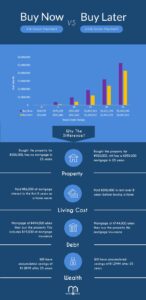Should you keep saving until you have 20% down?
You likely have heard this advice at least once in your life from your parents or friends. The underlying reason is because if you put less than 20% down (meaning your down payment is less than 20% of the purchase price of your property), you will have to pay mortgage insurance premiums. With today’s housing prices, if you don’t have 20% saved up now, waiting until you meet that goal will likely take you a very long time and hurt you financially. To illustrate our point, we’d like you to meet our hypothetical couple: Andy & Anne.
Income: Together they make $85,000 per year
Rent: They are paying $2,000/month
Expenses: They together spend $2,200 per month on everything else (phone, utilities, food, nights out, etc.).
Property Value: They want to buy a $500,000 home
Current Savings: They have accumulated $25,000 in savings (5% down payment)
What is Mortgage Insurance?
If you have good credit and your property qualifies for insurance, you pay for mortgage insurance in order to put down as little as 5%. Without mortgage insurance, your minimum down payment is 20%. You can read more about mortgage insurance and if you’d be eligible to apply for it in our Guide to Buying a Home.
How long does it take to save 20% down?
It would take Andy & Anne 8 years to buy a home with 20% down!
Sounds unrealistic? Let’s look at the main reasons why:
In the first year, Andy and Anne are able to save $730/month. In later years they contribute more as their salaries grow, so over the 8 years they are saving around $1,300/month.
To put down 20% on a $500,000 home, they’re short $75,000 ($100,000 – $25,000 savings). If they are short $75,000 and saving an average of $1,300/month, wouldn’t it just take 4.8 years ($75,000/$1,300/12) for them to buy? Not quite! The home they want for $500,000 today is appreciating at around 8% per year. In this case, by the time they buy that same property in 8 years it will be worth around $930,000, meaning they needed $186,000 for 20% down payment.
What is the financial impact of waiting?
By waiting 8 years to save up a 20% down payment, Andy & Anne will lose almost $1M in potential financial gains over 25 years.

Find out when you can afford to buy
Buying your first home is not as hard as you’d think, it just takes a plan! Perch recommends the following steps to get you on your way:
- Determine in what price range you’d ideally like to buy a home today.
- Create a Perch profile and start a home buying plan. Completing the first step takes 5 minutes and we give you an estimate of when your purchase date would be for your target property. Play around with assumptions, add a co-applicant, browse our suggested strategies to buy sooner, etc. until you lock down a plan that works for you.
- Revisit your profile every few months to monitor your progress towards your target purchase date.
- Once you’re within 6 months of buying a home, one of our mortgage experts will go over your profile with you and get you pre-approved to confirm that you’re ready to go property hunting and then get financing for your purchase. If you don’t have a Realtor, we’re happy to connect you with one of our vetted experts.
To learn more about the homebuying process, you can read our Guide to Buying A Home.
More about our assumptions
For those who want a bit more detail on the math behind the conclusions above, some key assumptions* are:
- Gross salaries increase 5%/year and they’re taxed at 30%
- Spending increases at 3%/year
- Rent increases at 2%/year
- Mortgage rate of 2.60% and amortization of 25 years
- Annualized property gains of 8% (which is roughly the 10 year average in Toronto).
- After paying taxes, expenses and their rent/mortgage, that monthly surplus is invested into their savings
- Savings earn a 5% annualized return
*Note that you can adjust these assumptions within your home buying plan to customize your results.
 Alex
Alex






